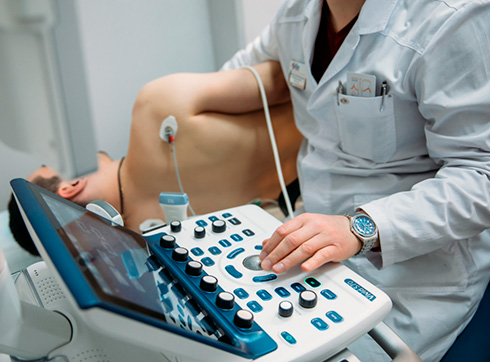1. The cardiovascular system:
- Electrocardiography;
- Holter (24-hour) ECG monitoring;
- Treadmill test (treadmill test);
- 24-hour blood pressure monitoring;
- Ultrasound examination of the heart (echocardiography);
- Vascular ultrasound (with color flow mapping).
2. Respiratory system. The study of the function of external respiration, allows you to assess the state of the broncho-pulmonary system, as well as to identify the presence of hidden lung diseases.
3. Brain. Dopplerography of the vessels of the brain (Transcranial Dopplerography).

Stress echocardiography with exercise
The test is carried out on a treadmill, during which an echocardiographic study is performed, and an electrocardiogram and blood pressure are recorded. The main purpose of this method is the diagnosis of coronary heart disease, the identification of zones of hibernated myocardium, the assessment of intracardiac blood flow. Due to ultrasound examination of the heart, this method has high sensitivity and specificity.
The method allows for 24 hours to record the work of the heart in an outpatient (home) environment. The advantages of this technique are that the doctor can track the presence / absence of rhythm disturbances at night, during the daytime, as well as identify the presence of life-threatening arrhythmias that require immediate correction, diagnose Prinzmetal's angina, and identify ischemic changes on the ECG. Carry out therapy adjustments.
The method allows you to record the level of blood pressure (BP) for 24 hours (during sleep, physical, mental stress, at different times after taking the drugs). Based on this technique, hypotension or hypertension is detected, the degree of nighttime decrease and morning increase in blood pressure, blood pressure response to physical activity and psychoemotional stress, degree and duration of hypertensive load on target organs, variability of blood pressure and pulse during the day, as well as an individual selection of medicinal therapy and control over its implementation. Also, this diagnostic method allows you to identify "white coat hypertension" - an increase in blood pressure in a patient only at a doctor's appointment (for example, due to stress), which, in turn, helps in deciding whether to prescribe drug therapy.
Treadmill test - a test with physical activity. Includes ECG and blood pressure monitoring while walking on a special treadmill. The purpose of this technique is the diagnosis of coronary heart disease; dynamic monitoring of patients after myocardial revascularization; dynamic assessment of exercise tolerance; assessment of the relationship of rhythm and conduction disturbances with physical activity; feature evaluation BP dynamics against the background of physical activity. According to the results of the treadmill test, the specialist determines the further tactics of managing patients with coronary artery disease. In the course of the study, you can individually select, the level of physical activity that will have a beneficial effect on the functioning of the cardiovascular system.
The test is carried out on a treadmill, during which an echocardiographic study is performed, and an electrocardiogram and blood pressure are recorded. The main purpose of this method is the diagnosis of coronary heart disease, the identification of zones of hibernated myocardium, the assessment of intracardiac blood flow. Due to ultrasound examination of the heart, this method has high sensitivity and specificity.
This technique allows you to quickly and accurately assess the functional state and work of the heart. ECG measures the frequency and regularity of the heartbeat. contractions (for example, the presence of extraordinary contractions), or the loss of individual contractions - arrhythmias. Electrocardiography reveals acute or chronic myocardial damage (myocardial infarction, myocardial ischemia), as well as metabolic disorders of potassium, calcium, magnesium and other electrolytes, violations of intracardiac conduction (various blockades). The method of diagnosing IHD is also used for stress tests. Gives an idea about the physical condition of the heart (left ventricular hypertrophy). May give information about non-cardiac diseases, such as pulmonary embolism. Allows you to remotely diagnose acute cardiac pathology (myocardial infarction, myocardial ischemia).
This study allows you to determine the functional state of the lungs, as well as to identify the presence of bronchopulmonary pathology.

This award is given to clinics with the highest ratings according to user ratings, a large number of requests from this site, and in the absence of critical violations.

This award is given to clinics with the highest ratings according to user ratings. It means that the place is known, loved, and definitely worth visiting.

The ProDoctors portal collected 500 thousand reviews, compiled a rating of doctors based on them and awarded the best. We are proud that our doctors are among those awarded.
Make an appointment at a convenient time on the nearest date




























Functional diagnostics of the K+31 clinic
This area of medical examination is aimed at early diagnosis and detection of pathologies, correction of diseases of the cardiovascular system, lung diseases, as well as conducting various functional tests to assess the reserve abilities of the body.
All methods used are highly effective and safe. Therefore, they can be carried out both for healthy people and for all categories of patients, and even for children and pregnant women.
Research conducted by doctors in the department of functional diagnostics K+31 will help determine the performance and reserves of your body.